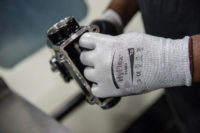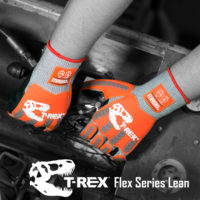Your workers who wear gloves are required to wrap their hands around a wide variety of surfaces — tool handles that can be made of wood, steel, or rubber; and items as varied as corrugated boxes, sheet metal, glass plates, drywall, rebar, ladder rungs, roof shingles, cement blocks, concrete or steel pipes, hot brake pads, traffic cones, lumber, steering wheels, welding torches, braided steel cable and many more.
Plus, these surfaces can be smooth or rough, burning hot, frozen cold, dusty, damp, wet, muddy, coated in crude oil, drilling lubricants, or transmission fluid. All the while, your workers are expected to be in control of their tools, equipment and environment. That is to say, they must have a strong grip on an enormously wide variety of surfaces, with a range of potential surface contaminants, under an array of different environmental conditions. Grip is not just important, it's critical — to your worker's ability to perform their job, their personal safety, and the safety of those around them.
Evaluating protection
As a safety professional, you have a variety of tools to evaluate glove protection such as ANSI/ISEA 105 and EN standards for abrasion and cut resistance, heat and flame resistance, protection from welding sparks, etc. You can request this data from the manufacturer.
But what good is a protective glove if your employees can’t hold on to their tools and equipment? More importantly, how do you evaluate the grip of a glove, when no formalized grip standard exists? Have two workers pull on opposite ends of a pipe soaked in oil? It's a start, but that's hardly scientific. On-the-job trials are the ultimate determining factor — but with hundreds of gloves to choose from, you need a tool to narrow down your options to the two or three best glove candidates before commencing a field trial.
Evaluating grip
You can start by asking glove manufacturers for comparative grip testing — how do they rank their gloves according to grip, on different surfaces and in varying conditions (dry, wet, oily, etc.)? Some manufacturers have developed in-house grip tests, and have tested a variety of glove palm materials on different surfaces and surface conditions. In fact, you can provide glove manufacturers with your particular “grip needs;” identify the surfaces and surface conditions that your workers deal with on a regular basis, and request that the manufacturer scientifically evaluate their gloves under your particular conditions.
What methods are available to evaluate grip? Most people think of a pull test or a torque test — i.e., two people pull or twist against each other on a pipe, with either water or oil coating the surface. Or an employee is asked to swing a hammer and then evaluate how much they had to squeeze to keep the hammer from flying out of their hand. The problem with these “tests” is the reliance on humans with a wide range of individual grip strength, muscle tone, fatigue, bone and joint anatomy, medical history, etc.
Explaining the coefficient of friction
A more reliable and scientific test will evaluate the coefficient of friction of a glove palm or fabric on a particular wet, dry or oily surface. The safety shoe industry has used standardized, machine-controlled coefficient of friction testing for many years to evaluate shoe grip on wet or oily floors. This same test method can be used to evaluate glove grip.
Here is a brief explanation of Coefficient of Friction (CoF):
CoF is a scientific measurement that evaluates the amount of force required to push an object across a surface, in the presence of a downward force pressing the object onto that surface. CoF is calculated as the ratio of these two forces — the required horizontal force (the force required to push the object) divided by the vertical force (the downward force pressing the object onto the surface). See the diagrams in this article.
This is a scientific measurement of the amount of friction between the bottom of the object and the surface it is in contact with. If the required “pushing” force is small compared to the downward force, then there is a small amount of friction, resulting in a low CoF value. On the other hand, if a large force is required to push the object, then there is a large amount of friction and a high CoF value.
Reducing hand & arm fatigue
So how does this test translate to glove grip? It is very straightforward — the higher the CoF value for a glove, the more grip that glove will have (on the particular surface it was tested). Wearing gloves with a high Cof value will reduce the potential for tool or equipment slippage, and enable the user to exert less energy squeezing or holding objects. This also results in a considerable reduction in hand and arm fatigue, which in turn further reduces the potential for dangerous incidences.
Some research has shown a tremendous variation in glove palm CoF values, depending on the surface and surface contaminants – gloves designed for dry grip could have a CoF of up to 1.8 on dry steel, but less than 0.3 on wet steel or 0.1 when coated in oil. Some new gloves have come to market that are specifically designed for grip in wet and oily environments, yet very few are scientifically tested for CoF to prove their grip.
Finally, remember that grip data is the starting point – it will help you narrow down your choices for which gloves to put in the field. The ultimate determination should always be made based on real world testing in the field.





